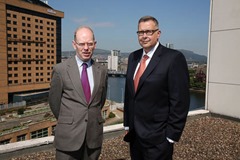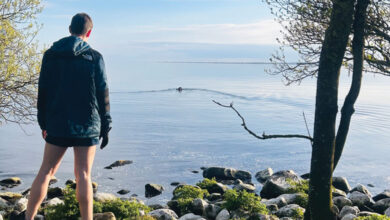Working together for growth
 While there are signs of economic recovery, PwC’s Paul Terrington argues that the local economy still faces significant challenges.
While there are signs of economic recovery, PwC’s Paul Terrington argues that the local economy still faces significant challenges.
He talks to Owen McQuade about the economic outlook and how the business sector can help drive growth particularly through greater collaboration within industry clusters.
“Clearly recovery is here. It is consolidating, unemployment has fallen steadily for the last 18 months and business sentiment as measured in the PMI has been positive for the past year. We are back to growth in output and gross added value (GVA).” PwC’s Regional Chairman for Northern Ireland Paul Terrington, sets out the good news regarding the local economy.
“That is good news but it is important not to confuse a cyclical upswing – which was always bound to happen – with a resolution of the more structural problems within the local economy, such as low private sector productivity and lack of public sector reform,” he continues.
Looking at the figures, he says it’s evident that Northern Ireland is recovering but at a slower rate than the UK average and well behind the leading regions like London and the South East of England. “Northern Ireland is, once again, at the bottom of the league table of UK regional growth,” he says.
Nevertheless, employment growth has been very impressive and Terrington says that is “commendable”. Last year saw over 15,000 more jobs or 2.3 per cent growth in the workforce, which is actually above the record growth rates seen in the period from the mid-1990s to 2007. “That is impressive but the question has to be asked how far is that allied to growth in productivity and hence to a real improvement in personal wellbeing? What we seem to be experiencing is growth in jobs above the UK average, but without any corresponding growth in living standards.”
“Our GVA compared to other regions is not improving and this has remained a fundamental issue for a long time. We are not progressing in this area and only by unlocking productivity will we get sustainable growth. Improved productivity: that is where the sustainable growth in the economy is going to come from. As Noble prize winning economist Paul Krugman said: ‘Productivity isn’t everything, but in the long run it is almost everything.’ It is a real worry that we are not making progress on this issue.”
Terrington refers to an interesting comment in the June minutes of the Bank of England’s Monetary Policy Committee meeting that refers to, the narrative of employment going up, productivity not moving and a flat wage growth. “The minutes suggest that people are prepared to work for lower wages, to work longer hours for the same wages or to prolong their working life past retirement because of fears for their continued income. This point really reflects the ‘productivity puzzle’ that we have in Northern Ireland.”
He warns that low productivity and the consequent lack of wealth creation across the local economy has also to be seen against a backdrop of a looming decrease in public expenditure. “Prepare for the prospect of higher interest rates as the Bank of England responds to a booming housing market in London and the South East of England. Whereas for us, with our property overhang still stifling investment and growth, this will be a big challenge. The second phase of public sector austerity will be much tougher than the first phase, which Northern Ireland effectively missed because of an overhang of public expenditure working its way through the system. In addition there are the, yet unknown, implications of welfare reform.”
Confidence is returning slowly but Terrington cautions that we shouldn’t get carried away as we still have many challenges ahead. “There are additional global challenges such as a slowing of the US economy, uncertainty over China and the lack of real growth in the euro zone. In Northern Ireland we have a disproportionately small private sector and an even smaller pool of exporters to drive international competitiveness and close the gap with other UK regions.”
The current PwC outlook is for the Northern Ireland economy to grow by 2.2 per cent in 2014, as compared to 3.0 per cent for the UK, which reflects the uncertainty in the US, China and euro zone economies. Terrington says some of these external pressures – like fears that unrest in Syria and Iraq could lead to higher oil prices are not always factored into domestic growth forecasting. “The Office of Budget Responsibility calculates that a 20 per cent increase in oil price equates to a 0.34 per cent loss in annual growth for the UK economy.” Additionally the Ukraine/Russia situation could hit Northern Ireland where local companies exported £80 million to Russia in 2012-2013: “While that’s a relatively small volume, it’s more than we export to each of the other three BRIC countries, so Northern Ireland has some exposure to trade sanctions if they toughen.”
For better or for worse, Terrington says these factors collectively impact on the Northern Ireland economy and the business community and elected representatives need to understand them and plan appropriately. “This will not take care of itself. You cannot just say there is an economic upturn now and we have to just let that happen. That is not the case. Our analysis highlights significant challenges for the local economy, not least in improving productivity. It is a challenging time and strong and informed leadership is essential, but the business community remains concerned at what feels like a political malaise. Interestingly, the politicians themselves now describe the political institutions as dysfunctional.
“In early February, I gave a speech at the annual IoD dinner and talked about trust. Nowadays trust underpins business; for any business, if you lose the trust of your customers it is fatal. The same things apply in the political world and it feels that trust between our politicians is steadily being eroded. This cycle of lessening trust makes progress much more difficult, whether you are in business life or political life.”
Clusters
Terrington refers to a recent Centre for Cities report, commissioned by Lord Sainsbury, which concludes that strong clusters should outperform the average of the economy. The report identified 31 clusters ranging from Scottish and Welsh tourism, Scottish whisky, furniture manufacturing in Yorkshire to the ‘motor sport valley’ in Northampton, which is the ‘jewel in the crown’ of clusters – a global cluster that understands its brand with 41,000 employees direct and indirect and a world class reputation – the benchmark for a great cluster.
But the report identified no clusters in Northern Ireland. Terrington comments: “Firstly, we were puzzled. Intuitively we thought that there were some strong clusters locally that stood up to comparison with many of the clusters identified in the Centre for Cities report. We then did a bit of digging and the Centre for Cities report, undertaken by management consultants McKinsey, stated that the quality of data for Northern Ireland was inadequate. Perhaps this reflects the fact that clusters in Northern Ireland tend to be smaller than elsewhere in the UK, which is because the Northern Ireland economy is much smaller than that of the UK as a whole. Ironically, when Lord Sainsbury, who commissioned the report, was Industry Minister he commissioned a similar report in 2001 and it identified eight clusters here in Northern Ireland, although that included clothing and textiles and shipbuilding.”
The report highlights the importance of clusters to the economy. The undertakings that make up the clusters account for 8 per cent of UK companies, but they employ 15 per cent of all employees and account for 20 per cent of UK output. Terrington sees this enhanced performance as a practical way of addressing the local economy’s productivity challenge. By nurturing local clusters, he says, we will help close the productivity gap with the rest of the UK.
When asked what are Northern Ireland’s clusters? Terrington replies: “Aerospace is the most obvious cluster in Northern Ireland, with £1 billion in annual revenues and with 8,000 employees.
“Another cluster is pharmaceutical and life sciences (which includes veterinary products), which, although not as big as aerospace, accounts for about £150 million in GVA and includes bigger companies such as Almac, Randox and Norbrook as well as smaller specialist companies; that too, is a significant employer with nearly 5,000 people.
“There is also a small but internationally significant cluster in quarrying machinery which accounts for 40 per cent of global output.”
Terrington sees the lessons from the report as being important for Northern Ireland. The first is the need to develop a strong and internationally-recognisable brand for each cluster and one cluster that needs its brand developed is the local agri-food sector. Great brands, he says, bind companies in the cluster together and are recognised internationally, attracting further investment and act as a cohesive marketing platform for enhancing product sales. “There is a large and vibrant local agri-food sector that comprises some very strong individual company brands, but looked at from an external perspective it doesn’t feel like a coherent cluster, certainly not when compared to the Republic of Ireland. We need to raise the profile of the sector internationally,” he says.
He says that tourism is similar to agri-food. Within tourism there are a number of strong brands, from hotel brands to individual attractions such as Titanic Belfast and the Welsh and Scottish tourism clusters were highlighted in the Centre for Cities report as having strong international brands. However, in John Hunter’s recent review of the Northern Ireland Tourist Board he sees a parallel to the Centre for Cities report as it calls for a much sharper focus on identifying and maximising the Northern Ireland destination brand.
Collaboration is also a key lesson from the Centre for Cities report where greater collaboration between the companies in the cluster is vital. In most clusters, the companies are rarely direct competitors particularly if they are export focused and they have a lot in common and would benefit from learning from each other.
An example of this is the emerging business and financial services cluster in Northern Ireland, which has created 4,000 new jobs in the past 24 months alone. Terrington elaborates: “As an organisation within this cluster, PwC looks at how we learn from a range of other business service providers. For example, some of the things we are doing internationally from Belfast such as running large international funds, we have compared notes with different fund management companies to learn from each other and also to collaborate.
As the sector grows, the ability to attract talent will be critical and collaborating to build a cluster brand will help attract new talent and investment into the sector.
An example of this is PwC’s global international research operation which is based in Northern Ireland and which regularly attracts talent specifically to come here to work in that sector.
Another aspect of the report on growing clusters is the role of universities and colleges. As the organisations within the cluster develop the cluster’s brand, the next phase is how to enhance product offerings through innovation and R&D. “When you look at successful clusters, the universities and colleges have a key role in that and as we are finding in PwC; businesses can also play innovative roles in training through, for example, promoting higher apprenticeships.”
The Centre for Cities report on clusters delivers clear evidence that clusters drive productivity well above than the UK average and Terrington says we should use the lessons of clusters to address some fundamental problems of improving productivity in the local economy.
He concludes: “We see this report from a positive aspect – to challenge ourselves. Government is only part of the answer. There is a role for individual companies to reach out and collaborate to build world-class clusters in Northern Ireland, much like our aerospace sector has.
“There might be the need for a catalyst or stimulus from government but it is really up to the companies themselves to work on this. It is up to the Executive to create the context of trust and let businesses build cluster brands that can be truly international in nature to attract investment and talent.”







